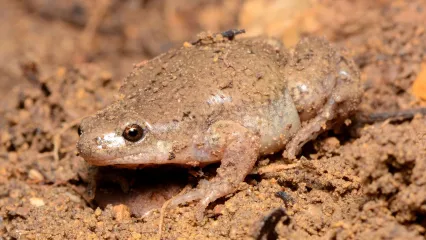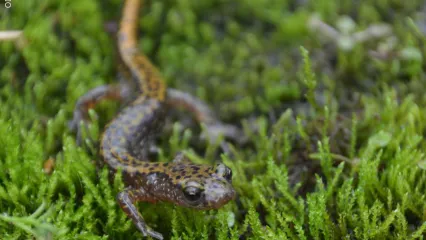
Description
Western narrow-mouthed toads have an unusual shape. These small frogs have pointed snouts and narrow heads that facilitate burrowing. Additionally, the mouth is very small compared to other kinds of frogs. The oval body has smooth skin that is gray, tan, or olive green with some small black flecks or dots on the back. The belly is light-colored with no marks. The similar eastern narrow-mouthed toad is not greenish in dorsal coloration and has a belly with dense black markings. A distinctive character of both species is a fold of skin behind the eyes across the back.
The small tadpoles have flattened grayish-tan bodies. The eyes are located on the sides of the head. They typically float in midwater.
The calls of western narrow-mouthed toads are somewhat similar to those of bleating sheep; the call has also been described as a nasal buzz. These distinctive calls can be deafening in a large chorus. The toads’ dark color combined with calling positions in water at the base of aquatic vegetation makes them very difficult to locate when calling.
Size
Western narrow-mouthed toads are typically 7/8 to 1 ½ inches in body length. Females are larger than males.
Habitat
Western narrow-mouthed toads occur throughout much of Texas, Oklahoma, and Kansas and barely into southern Nebraska and parts of Illinois. Isolated populations are found in Arkansas, Colorado, New Mexico and Arizona.
Life Cycle
These small toads breed in late spring and early summer. Large choruses form after heavy rains. They use temporary ponds and ditches, edges of marshes, flooded fields, and similar sites for breeding. Eggs are in small packets and form a single-layered film on the surface of the water. Clutch size varies from 600 – 2,000 eggs. Because the toads have bodies that are round with short legs, males cannot grasp females in amplexus like other frogs. Instead, the males have glands on the chest that secrete a sticky mucous. A male literally glues itself to the back of a female during mating. Tadpoles require 20 – 30 days to reach metamorphosis.
When not breeding, adult frogs are frequently found under rocks on rocky hillsides or under other cover objects. They have a mutualistic association with tarantulas. Tarantulas inhabit holes under rocks, and one or two western narrow-mouthed toads can be found in a tarantula’s hole, sometimes sitting under the tarantula. Apparently the toads have chemicals in their skin that protect them from being recognized as food by the tarantula. Because the toads feed heavily on ants, they may prevent ants from inhabiting the tarantula’s burrow.
How To Observe
These small frogs are very difficult to observe. Even in a large chorus at night, they are difficult to locate with a flashlight or headlamp. If a large number of calling males can be localized to a certain area, a dip net may yield a few individuals.
(This profile was created by Dr. Laurie Vitt as part of a partnership between the Wildlife Department and the Sam Noble Oklahoma Museum of Natural History. It was funded as part of a larger grant to survey and inventory amphibians and reptiles of the Wildlife Management Areas of Oklahoma: T-35-P-1.)


